How to choose an air conditioner: recommendations for choosing + TOP 5 best brands
Installing an air conditioner in an apartment significantly increases comfort.This is relevant not only for residents of the southern regions, but also for northerners who have a harder time withstanding the summer heat. Agree, it’s nice to plunge into the coolness of home when it’s unbearably hot outside.
A properly selected air conditioner cools or heats the air in the room, and some models can slightly dry it out or make it more humid. Operating the device is so simple that even a child can handle it.
All that remains is to figure out how to choose an air conditioner for your home. In the article we will talk about the types and capabilities of modern models, their functions and technical characteristics. And at the end, we will present the best brands specializing in climate control equipment.
The content of the article:
Classifications of air conditioners for home
The variety of cooling equipment on the domestic market is simply enormous: you can find a compact device for servicing a small room or a powerful multi-system for a spacious country house.
To make it easier to navigate this assortment of models when choosing, we will first introduce you to all the current types.
#1 – by design
According to their design features, all air conditioners are divided into monoblock And two-block. The second are the well-known and most popular split systems for home use.
The difference can be determined by the names of the categories: monoblock ones consist of one block, two-block ones - of two, internal and external.

The advantages of a monoblock include simple self-installation and relatively low cost. Cons: Loud noise, limited performance, and potential duct installation difficulties.
For city apartments or private houses, monoblock devices are rarely purchased due to the listed disadvantages, much more often - for offices or small industrial premises.
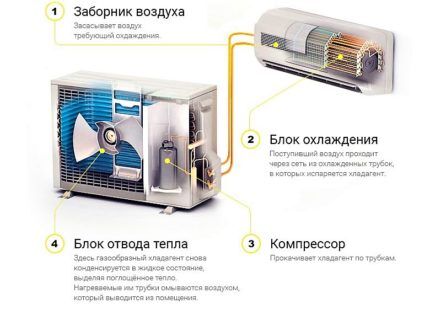
The compressor and condenser are located in the outdoor unit, the evaporator is located in the indoor unit. Both modules are connected by copper pipes with circulating refrigerant.
There are models with one outdoor unit and several indoor units - these are multisystems. Their attractiveness is that they can serve several rooms at once. Such configurations are often used when landscaping cottages.
If you have a standard city apartment, then we recommend a compact but efficient split system with one internal module. This option works relatively quietly and efficiently in several modes, saving energy.On the market you can find a model for any budget.
There are also disadvantages - you will have to involve specialists in the installation; it is quite difficult to install both units yourself and connect them to each other. The second technical disadvantage is that not all models are capable of operating at very low outdoor temperatures.
#2 – by installation method
Both split systems and monoblock structures come in different installation methods.
Monoblocks are divided into 2 types: window And floor. The first ones are installed in the window opening, adjusting the frame to fit. If you have new expensive windows, it is better to abandon this design.
Floor-standing ones are placed on the floor, but with some conditions:
- location - by the window;
- there is a hole in the window for the air duct outlet;
- The floor covering tolerates high humidity well.
An important nuance: the exit point of the corrugated pipe must be sealed. If it is placed in a slightly open sash, the air conditioner’s operating efficiency will be low.
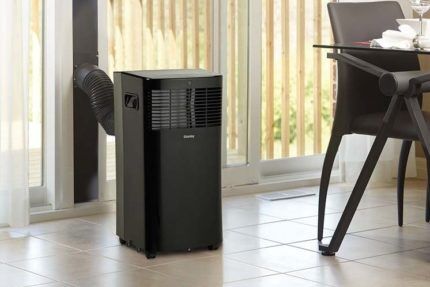
If you often move from place to place and like coolness, floor-mounted monoblock air conditioners are the most suitable option.
There are many more types of split systems:
- wall;
- floor-ceiling;
- channel;
- cassette.
About 85% of home appliances sold in specialty chain stores are classified as wall split systems.
They are distinguished by a simple design, clear controls, and a pleasant design of the internal module.

Floor-ceiling the units are more powerful and are designed to serve spacious premises - shopping centers, offices, halls. They are also good for spaces with glass walls, since the units can be mounted on the ceiling or floor.
Cassette models for the home are used in very rare cases, but in establishments designed to accommodate a large number of people, they are often found.

Duct air conditioners also masked with suspended structures. Home systems are smaller and noisier, while industrial systems are larger in size, performance and power.
It makes sense to install cassette or duct systems in cottages with a large number of spacious rooms. For small city apartments, the best option is a wall-mounted split system.
#3 – according to the principle of action
Another classification is based on the operating principle of the control system, or more precisely, the compressor or inverter.
All air conditioners are divided into:
- linear;
- inverter
First group linear model, always “works” at maximum power. As soon as the set temperature is established in the room, the device simply turns off and then, based on a signal from the temperature sensors, turns on again. This happens all the time.
As a result, temperature changes are observed, and sometimes this is quite noticeable.
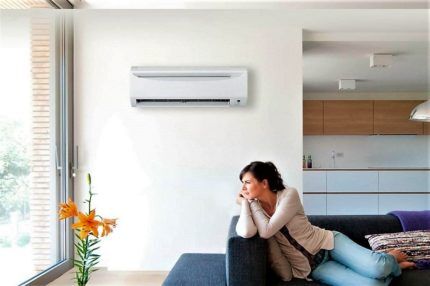
Inverter air conditioners switch gradually, smoothly. This is due to the operation of the inverter, which alternately converts alternating current into direct current and vice versa. Thanks to this, performance changes, and subsequently energy consumption. As a result, inverter models consume less energy resources.
Advantages of inverter units:
- constant maintenance of a certain temperature;
- quick response to changing settings;
- higher energy efficiency – savings reach 50-60%;
- low noise.
It will cost more money to purchase an inverter model or repair it, but such models are ideal for children's rooms and bedrooms with increased requirements for silence and maximum comfort.
Basic and additional operating modes
The next nuance that must be discussed before purchasing is determining the list of necessary modes. The fact is that in addition to the main function - cooling the air in the room - the air conditioner can perform other tasks.
The most expensive multifunctional units are capable of operating in 5 modes:
- cooling;
- heating;
- hydration;
- drainage;
- ventilation.
Cooling - the main function present in all devices without exception. Thanks to it, the temperature in the air is reduced to the one specified by the settings, and then maintained at the same level.

Heating - an additional function, and for most models it only works in a certain range.
When the outside temperature drops below the critical point - from -5 ° C to -15 ° C, depending on the manufacturer's standards - the device turns off the air heating.
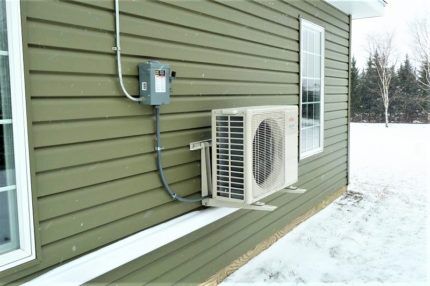
Functions drainage And moisturizing Not all models are available, so we also advise you to inquire about these capabilities in advance. More often, the air in living rooms is dry, so it would be much more advisable to buy a special device - a humidifier. It operates on a different principle and is more gentle on the human respiratory system.
But the function ventilation Many devices have it. It creates circulation and helps distribute air evenly throughout the room. As a result, warm air is mixed with cold air, which is more beneficial for the health of residents.
Versatility is good, but experimenting with modes is not useful for everyone, so consult your doctor before purchasing a multifunctional device.
Technical characteristics overview
If you already know which type of air conditioner is best suited for your home and have decided on your budget, it would be a good idea to look at the product data sheet to learn more about the technical characteristics. They are no less important than the number of modes or type of compressor.
Let's consider the parameters on which the energy consumption and ease of use of the device depend: power, noise, energy efficiency, control method.
Parameter No. 1 - power and working area
On power selection The area of the room directly affects. It is customary to calculate based on the ratio: to cool 1 m² of area, 100 W are required.
Therefore, for a 20-meter living room you need to buy a unit with a power of 2-2.2 kW. But do not forget that powerful devices produce louder noise.
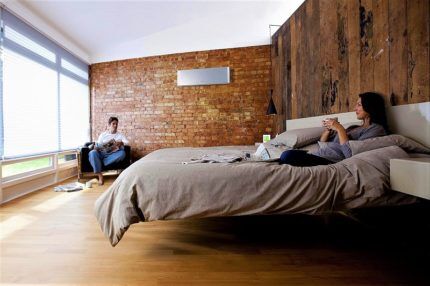
For larger rooms, a more detailed calculation is required.
There are calculators that take into account such accompanying factors as:
- presence of windows and glazing area;
- number of floors, location of the apartment (corner, sunny side), ceiling height;
- average number of permanent residents;
- the presence of electric lights and heaters - radiators, stoves, etc.
But for a standard room of 15-20 m², careful calculations are not required; average values are usually sufficient. Some manufacturers, in addition to power, also indicate the recommended maximum room area.
Parameter No. 2 - noise level of the indoor unit
There are always household appliances in the house that produce various noises. For example, a refrigerator that periodically turns on and sometimes hums quite loudly. It is clear that an additional “loud” device is undesirable, so noise level is one of the important parameters.
For inverter models it is usually less. Some devices in cooling mode produce a quiet and monotonous noise not exceeding 20 dB. This is an excellent indicator, suitable for bedrooms and children's rooms.

Unfortunately, manufacturers do not always provide reliable information. Sometimes in the technical data sheet you can only find the level characteristic of the device operating in “night” mode. We advise you to look for reviews from real users before purchasing.
Parameter No. 3 - energy consumption class
By ignoring the energy efficiency of the unit, you can end up with a large sum of money when paying utility bills in the hot months. It is better to immediately choose an economical device - and most likely it will be an inverter.
Energy efficiency is indicated by the letter symbols A ... G. Economical ones are marked with the sign A, and now almost all modern models correspond to this class. But it’s even better if the air conditioner you choose is class A++ or A+++.
Parameter No. 4 - availability of additional features
Let's look at what other useful additions home air conditioners have. But, before looking for a model with the listed capabilities, decide whether you really need them. Each useful option increases the overall cost of the device.
Night mode, aka sleep mode. This is the ability of the air conditioner to operate at low power with minimal noise - ideal for a night's rest.
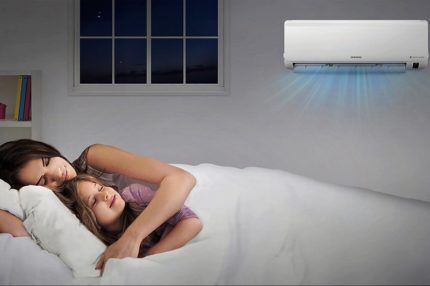
Timer, regulating the exact on/off time. An excellent addition, convenient for everyone - when you return home, you don’t have to wait for comfortable conditions, the split system will cool the air to the set temperature when you arrive.
3D stream – the ability to adjust the air flow in all directions.Traditionally designed blinds only direct air up/down, while with the 3D function they additionally move left/right.
There are premium models that direct cooled air to the location of the remote control. If you sit with the remote control on the sofa, the breeze will blow towards the sofa.
Turbo mode necessary for operational cooling. If you forget to set the timer, this function will come in handy - the device will turn on at full power and change the microclimate in the room in a matter of minutes.
Self-diagnosis – the ability of the device to independently identify faults and report them to the consumer by displaying alphanumeric characters on a digital display.
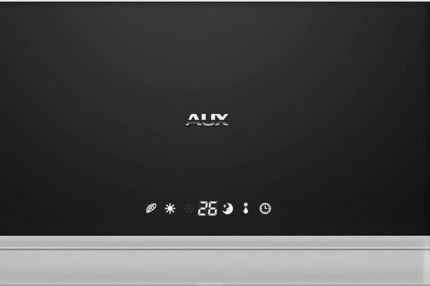
Air cleaning is produced thanks to the filter system installed in the indoor unit. It may consist of one or several filters: the simplest devices are equipped with one that traps dust, while more expensive ones have fine filters that prevent even the smallest particles and odors from passing through.
Filters require timely replacement, but they are not cheap, and here you have to choose between air quality and efficiency.
Decide in advance whether you need these functions and do not forget: the more complex and functional the device, the greater the likelihood that one of the elements will fail.
TOP 5 popular brands
Due to the large number of manufacturers of household appliances, one or the other company takes the lead. This is facilitated by worldwide fame, the popularity of budget lines, and the regular appearance of new or improved models.
Our rating includes brands whose products received the most positive reviews from users and experts.
Brand #1 – Mitsubishi Electric
A Japanese company that annually produces new series of climate control equipment.
Pays great attention to split systems for home use, not only introducing first-class technical developments, but also implementing excellent design solutions.
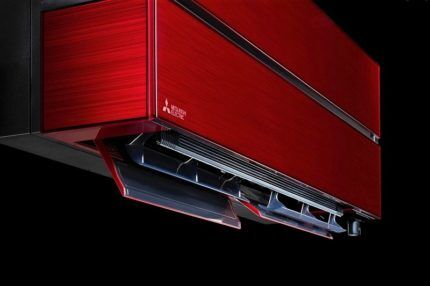
Home appliances, among which you can find all types according to installation method, serve areas from 15 m² to 100 m². The noise level of the latest modifications is no higher than 19 dB.
We also recommend that you learn about error codes for Electolux air conditioners. More details - go link.
Brand #2 – Electrolux
A Swedish manufacturer that constantly supplies the Russian market with new high-tech series. For example, the PROF AIR line is known for creating an ideal microenvironment for living in a room, as fresh and clean as possible. This happens thanks to Pull & Clean technology.

All models are distinguished by a high energy efficiency class - up to A+++ in both main modes, quiet operation and additional features
Brand #3 – Haier
A Chinese company that has won the appreciation of even demanding European consumers who value maximum comfort and reliability.
Products are sold in more than 100 countries and are valued for their high performance and bold design.
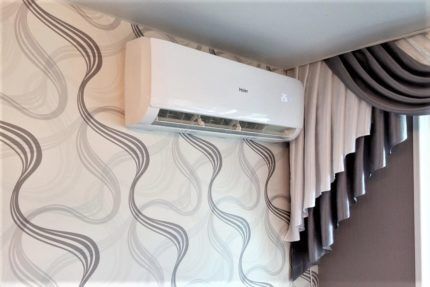
The latest developments of the brand are especially attractive - wi-fi control units, models with a built-in ultraviolet lamp or the O2-Fresh option, which provides an influx of fresh air.
Brand #4 – Ballu
The international concert has considerable capacity in Russia, so you can always find the latest developments in the field of climate control technology on the market. Among the household solutions are inverter and conventional split systems, multi-systems, floor-standing and mobile series.

No less popular are the Free Match multi-split systems, specially designed to serve large cottages. Quiet, efficient and stylish, they are also suitable for cooling offices or hotels.
Brand #5 – Samsung
The world-famous South Korean company is famous for constantly introducing the latest technologies, which then become a model for other manufacturers.
For example, the latest models of air conditioners have been released in a triangular design, which improves efficiency and increases the cooling speed.
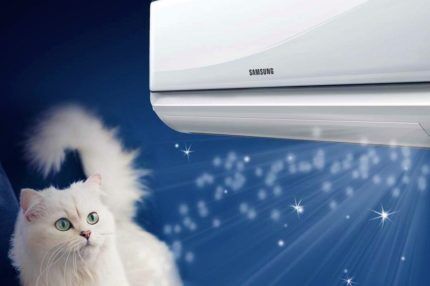
For people with increased sensitivity to dust, devices with Ultra Wide PM 2.5 filtration have been created. The manufacturer claims that within 100 minutes the air in the room is purified by 99%.
conclusions
Practical tips for choosing an air conditioner:
Several important selection criteria:
As you can see, the range of air conditioners for the home is large, and to choose, you need to consider everything, from technical nuances to design features.
We suggest expanding the topic of the article and discussing various models - from our rating or others. If you use an air conditioner, please leave a comment and tell us what makes your device special.
Share your stories of choosing a split system or monoblock for an apartment. Or maybe you bought a duct or cassette air conditioner for a country house? Your experience in choosing a model will be very useful to our readers.



